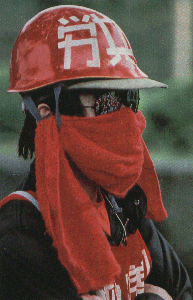Colloquially, the burakumin people are called "eta,"
"穢多," literally, "an abundance of defilement" or "an abundance of filth"
If you are descended from an "eta" family,
don't even think of being formally hired as a regular Toyota employee.
don't even think of being formally hired as a regular Toyota employee.
But you can work for the yakuza who cooperate with Toyota.
From the 14th century until the middle of the 17th century the Japanese rulers had been creating a division of people according to occupation. The buraku are most likely descended from people who were defeated in earlier feudal wars or from people who ignored traditional Buddhist tenets and so became defined as outcasts (or impure). Those considered to be lesser artisans and cleaners among others, were categorised as burakumin. They were treated as eta - extreme filth, and hinin - nonhuman. They lived in settlements known as hisabetsu buraku or 'discriminated hamlets'.
 However, the buraku look like other Japanese people, but remain an underprivileged minority, due to caste-like discrimination. Today, there are up to 6,000 burakumin districts and between 1.2 to 2 million buraku in Japan (about 2% of the population). The social practices of exclusion have resisted change. Discrimination continues today, particularly in employment and marriage as well as in communicating with public officials. Activists groups have sought change and protests have occurred, especially where it is felt that the police target the burakumin population and districts (which some describe as ghettos) on the basis that law enforcement offices consider them to be inclined to criminal behaviour. Such profiling is an awful bias which is being fought against.
However, the buraku look like other Japanese people, but remain an underprivileged minority, due to caste-like discrimination. Today, there are up to 6,000 burakumin districts and between 1.2 to 2 million buraku in Japan (about 2% of the population). The social practices of exclusion have resisted change. Discrimination continues today, particularly in employment and marriage as well as in communicating with public officials. Activists groups have sought change and protests have occurred, especially where it is felt that the police target the burakumin population and districts (which some describe as ghettos) on the basis that law enforcement offices consider them to be inclined to criminal behaviour. Such profiling is an awful bias which is being fought against.
Japan’s elaborate system of 'family registers' which is a record of each person’s ancestry also makes it almost impossible for a buraku to conceal his or her origins. Making it difficult to work for a major company or marry outside the so-called caste. Parents routinely investigate the background of their children’s prospective marriage partners and a pending marriage may be broken up by strong objections from a family member, if the partner is considered to be from the burakumin. While discrimination is illegal, such attitudes and practices still persist.
One of the occupations that has continued to the present day is the handling of dead animals and human corpses, including butchering and tanning.
From Wikipedia article on Burakumin:
"Tokushu
Buraku Chimei Sōkan" incident
In November 1975, the
Osaka branch of the Buraku Liberation League was tipped off about the existence
of a book called "A Comprehensive List of Buraku Area Names" (特殊部落地名総鑑 Tokushu Buraku
Chimei Sōkan). Investigations revealed that copies of the hand-written
330-page book were being secretly sold by an Osaka-based firm to numerous firms
and individuals throughout Japan by a mail order service called Cablenet, at
between ¥5,000 and ¥50,000 per copy. The book contained a nationwide list of
all the names and locations of buraku settlements (as well as
the primary means of employment of their inhabitants), which could be compared
against people's addresses to determine if they were buraku residents.
The preface contained the following message: "At this time, we have
decided to go against public opinion and create this book [for] personnel
managers grappling with employment issues, and families pained by problems with
their children's marriages."
More than 200 large
Japanese firms, including (according to the Buraku Liberation and Human Rights
Research Centre of Osaka) Toyota, Nissan, Honda and Daihatsu, along with thousands of individuals
purchased copies of the book. In 1985, partially in response to the popularity
of this book, and an increase in mimoto chōsa (身元調査, private investigation
into one's background) the Osaka prefectural government introduced "An
Ordinance to Regulate Personal Background Investigation Conducive to Buraku
Discrimination".
Although the production and
sale of the book has been banned, numerous copies of it are still in existence,
and in 1997, an Osaka private investigation firm was the first to be charged
with violation of the 1985 statute for using the text."******************************************************************************
Burakumin yakuza membershipfrom wikipedia
According to David E. Kaplan and Alec Dubro in Yakuza: The Explosive Account of Japan's Criminal Underworld (Reading, Massachusetts: Addison-Wesley Publishing Co., 1986), burakumin account for about 70 percent of the members of Yamaguchi-gumi, the biggest yakuza syndicate in Japan. [and the currently 'don' of the Yamaguchi-gumi is the former head of the Kodo-kai, the Nagoya clan with close ties to Toyota.)
Mitsuhiro Suganuma, the ex-member of Public Security Intelligence Agency, testified that burakumin account for about 60 percent of the members of the entire yakuza.[9]
*******************************************************************************************************So what seems to be happening is that the formally employed people in large Japanese enterprises, the regular "salaryman" workers with lifetime employment prospects, are hired with careful exclusion of anyone with an outcast background. But then those outcasts join the yakuza groups and act as temporary workers in construction and possibly also in other kinds of invisible jobs.
